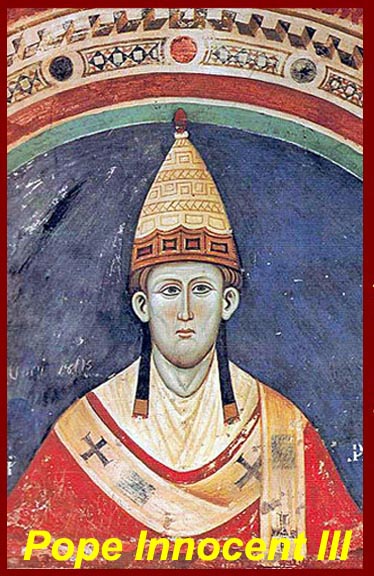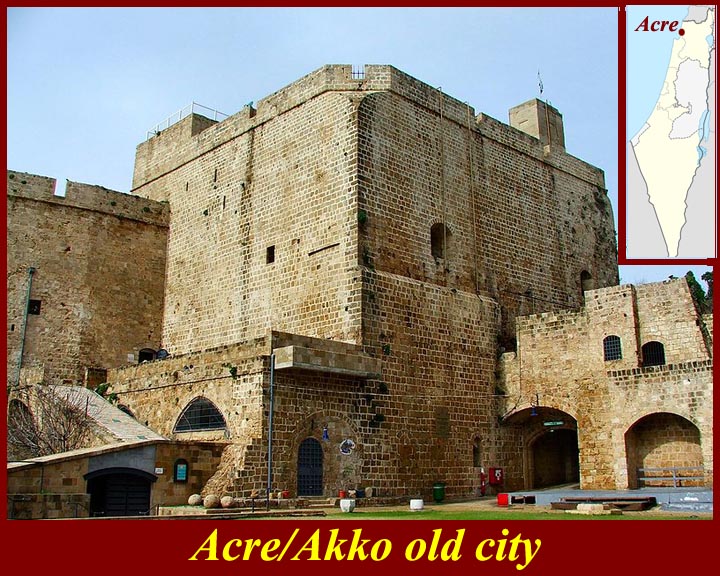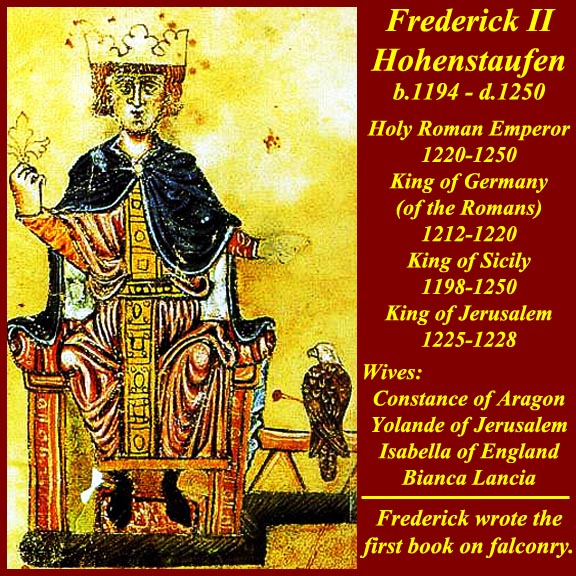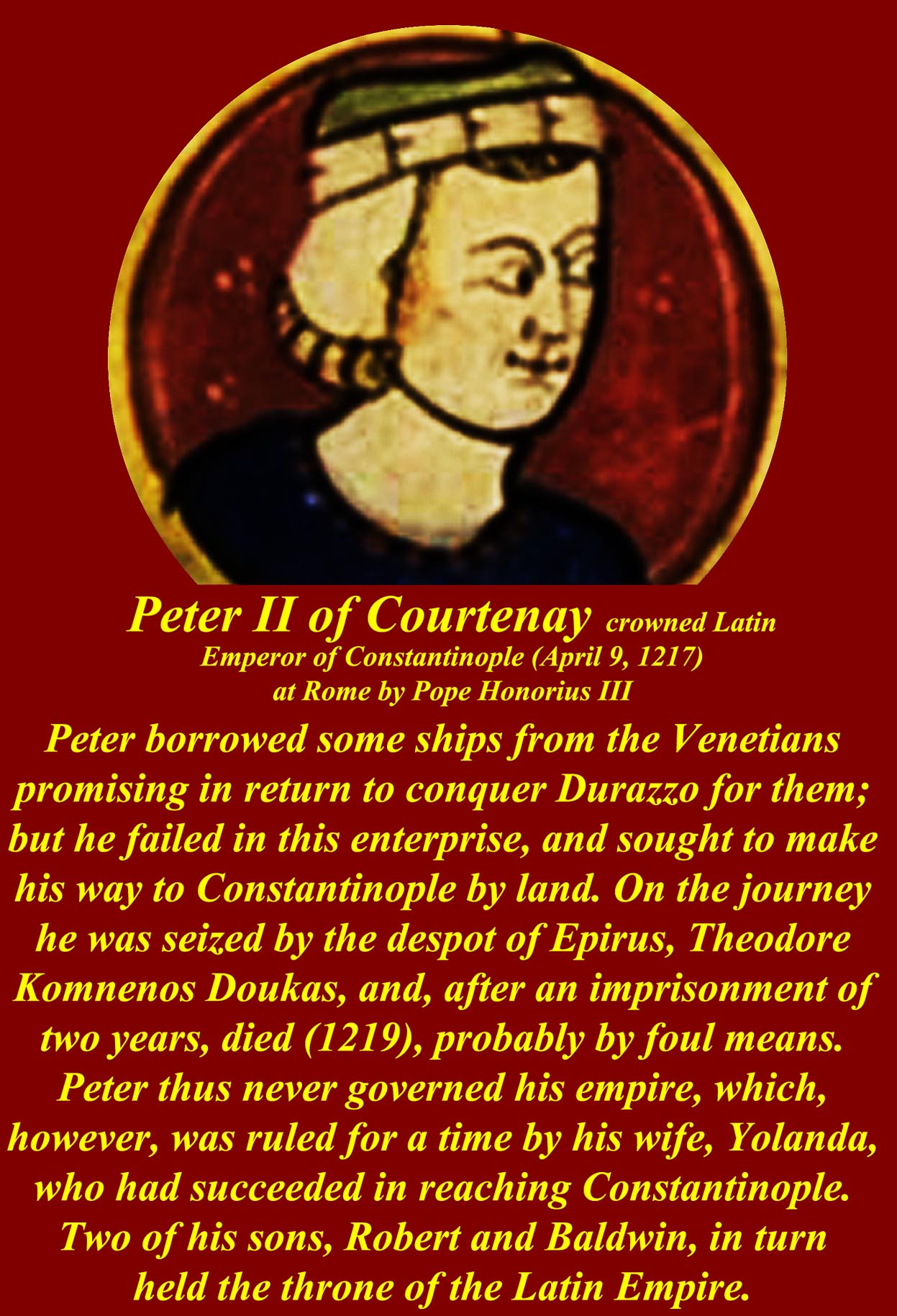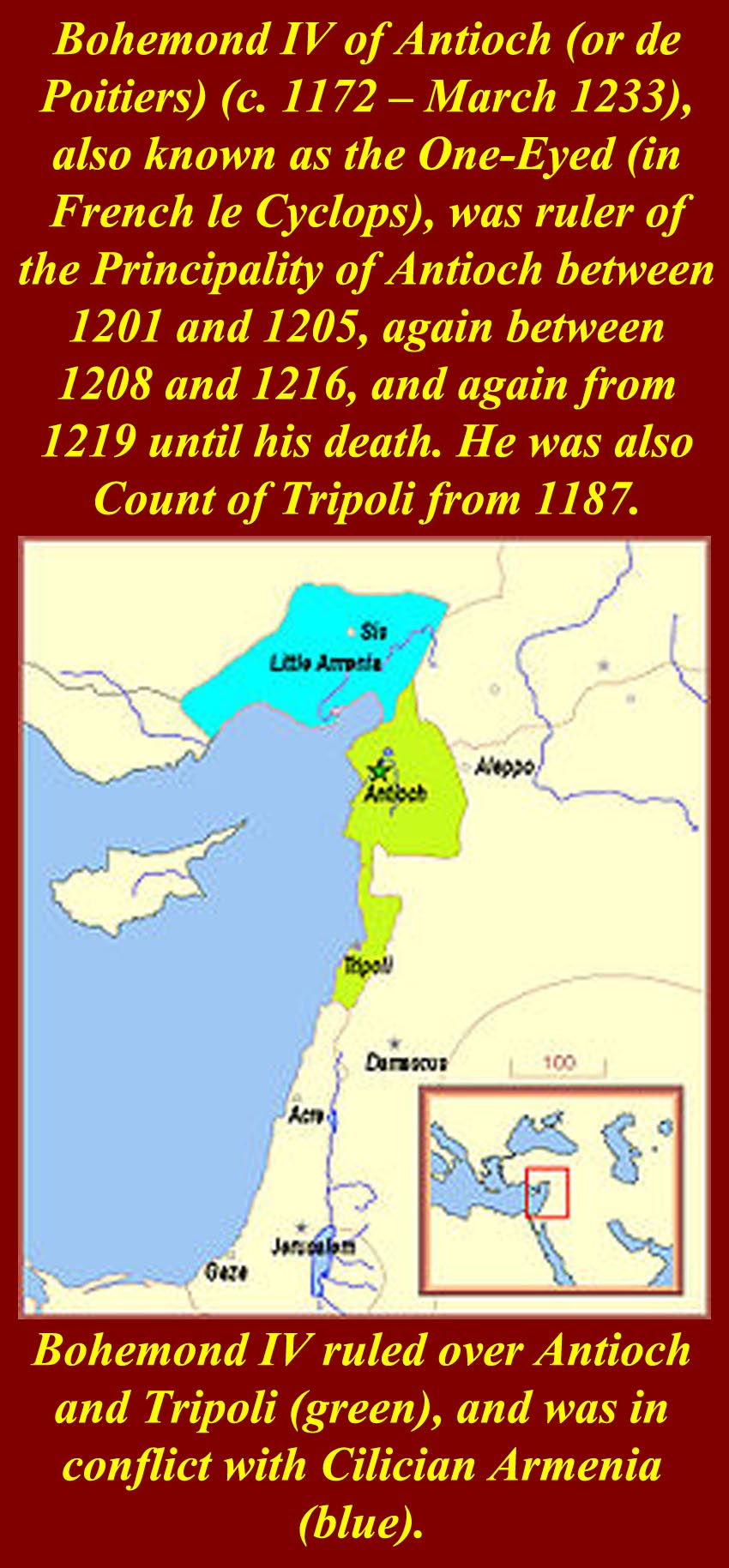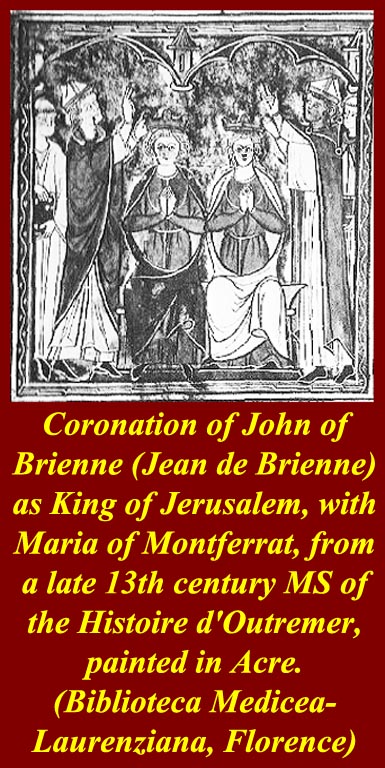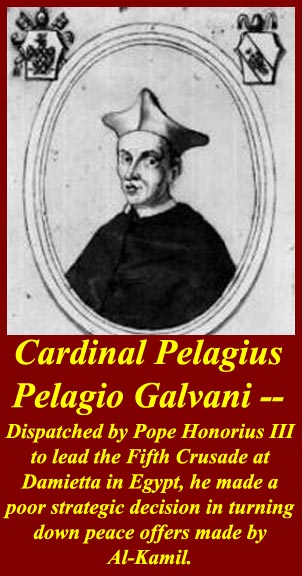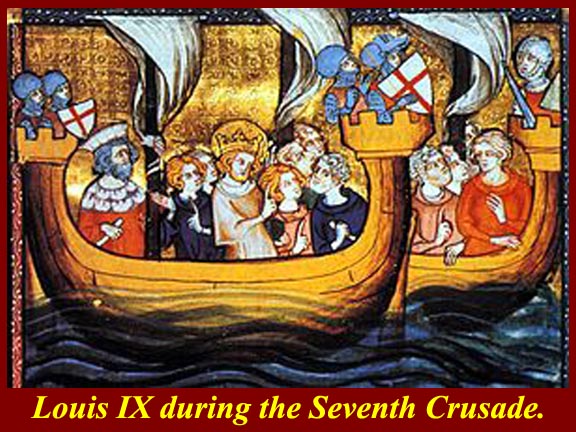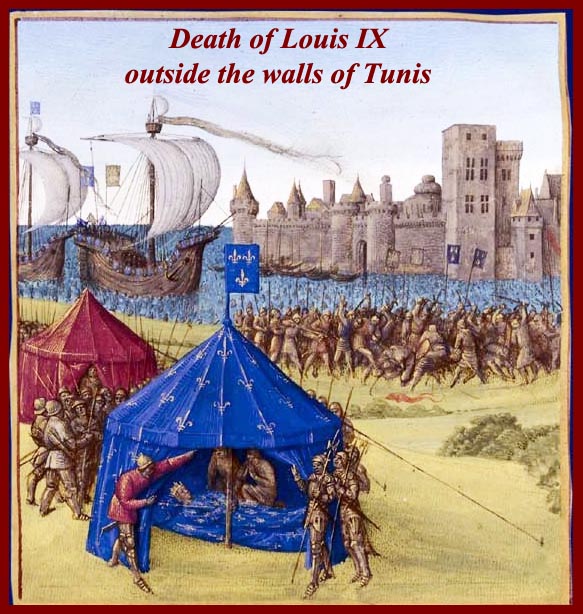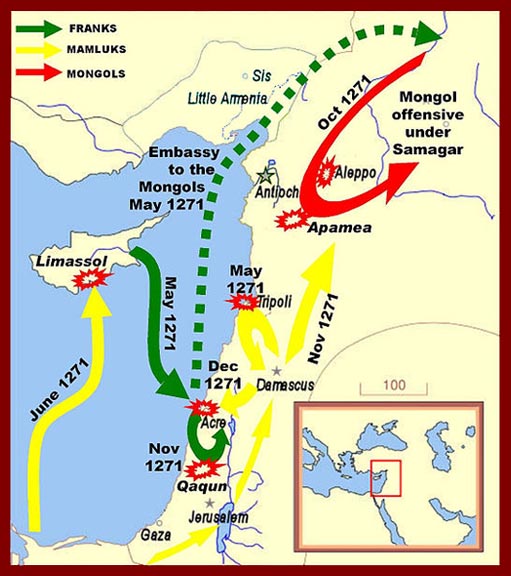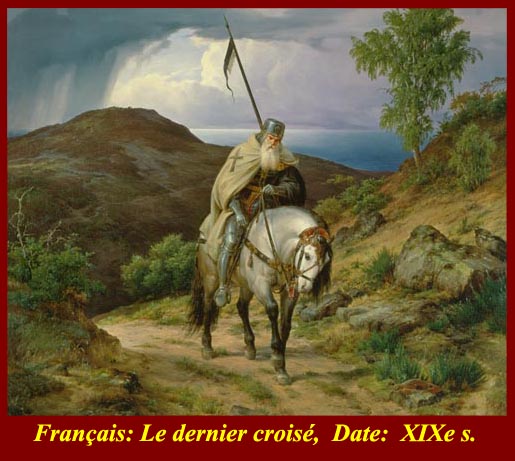Later Crusades 5, 6, 7, 8, 9
Note: Almost all underlined words and texts are links to other pages. Explore!!
From http://en.wikipedia.org/wiki/Fifth_Crusade
| Fifth Crusade 1213 - 1221 |
|
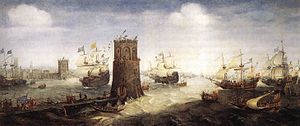 Frisian crusaders
confront the Tower of Damietta, Egypt.
|
|
| Date | 1213–1221 |
| Location | Egypt |
| Result | Muslim victory. Decisive Egyptian victory; eight year peace treaty between Ayyubid Empire and European kingdoms |
| Belligerents | |
| Crusaders | Egyptians |
| Commanders and leaders | |
Kaykaus I |
|
| Strength | |
| 32,000 men | Unknown |
| Casualties |
|
| Unknown |
Unknown |
The Fifth Crusade (1213–1221) was an attempt to reacquire Jerusalem and the rest of the Holy Land by first conquering the powerful Ayyubid state in Egypt.
Pope Innocent III and his successor Pope Honorius III organized crusading armies led by King Andrew II of Hungary and Duke Leopold VI of Austria, and a foray against Jerusalem ultimately left the city in Muslim hands. Later in 1218, a German army led by Oliver of Cologne, and a mixed army of Dutch, Flemish and Frisian soldiers led by William I, Count of Holland joined the crusade. In order to attack Damietta in Egypt, they allied in Anatolia with the Seljuk Sultanate of Rûm which attacked the Ayyubids in Syria in an attempt to free the Crusaders from fighting on two fronts.
After occupying the port of Damietta, the Crusaders
marched south towards Cairo
in July 1221, but were turned back after their dwindling
supplies led to a forced retreat. A nighttime attack by
Sultan Al-Kamil resulted in a great
number of crusader losses, and eventually in the surrender
of the army. Al-Kamil agreed to an eight-year peace
agreement with Europe.
.... More at http://en.wikipedia.org/wiki/Fifth_Crusade
Timeline of the Fifth Crusade
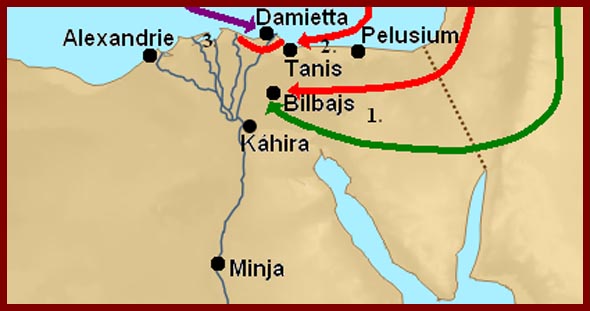
below to enlarge
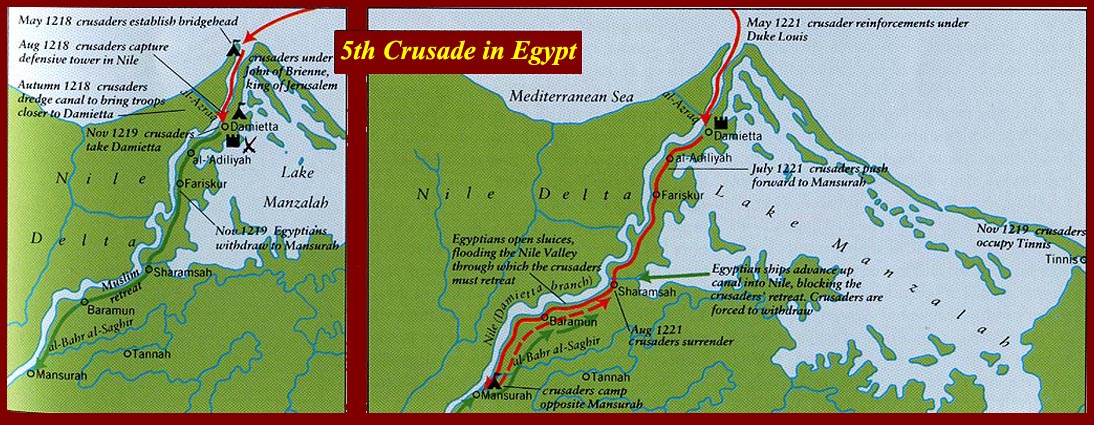
http://www.mmdtkw.org/CRUS080503-5thCrusadeNile.jpg
Fifth Crusade failed Nile Campaign -- July-August 1221
(Click on image or link to enlarge)
| Sixth
Crusade The Sixth Crusade started in 1228 as an attempt to regain Jerusalem. It began seven years after the failure of the Fifth Crusade. It involved very little actual fighting. The diplomatic maneuvering of the Holy Roman Emperor, Frederick II resulted in the Kingdom of Jerusalem regaining control of Jerusalem and other areas for fifteen years. |
||
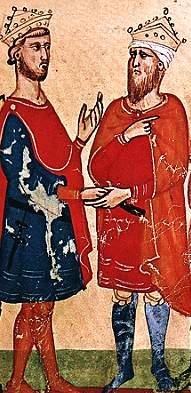 Frederick II (left) meets al-Kamil (right). |
||
| Date | 1228–1229 | |
| Location | Cyprus, Near East | |
| Result | Decisive Crusader victory | |
| Territorial changes | Jerusalem, Nazareth, Sidon, Jaffa, and Bethlehem relinquished to Crusaders | |
| Belligerents | ||
| Holy Roman Empire and allies | ||
| Commanders and leaders | ||
Success
- though not by military might. It was led by Holy Roman
Emperor Frederick II of Hohenstaufen, King of Jerusalem
through his marriage to Yolanda, daughter of John of
Brienne, King of Jerusalem.
Frederick had promised to participate in the Fifth
Crusade but failed to do so, thus he was under a great
deal of pressure to do something substantive this time.
This Crusade ended with a peace treaty granting
Christians control of several important holy sites,
including Jerusalem.
|
Sixth Crusade
1222 - 1244 (concurrent with the Cathar
Crusade, the Baltic Crusade, the Reconquista |
||
|
1222 |
Now in his
seventies, John of Brienne travels to Europe in
order to find a husband for his eleven-year-old
daughter, Yolanda. The task is difficult because
whoever marries her will rule the Latin Kingdom of
Jerusalem.
becoming not only responsible for what little
remains of it but also for the recapture of the
many cities controlled by Muslims - including Jerusalem
itself. This is an honor that few desire, but
Frederick II decides to accept, even though an
actual marriage would not occur until she reached
the legal age of 14. |
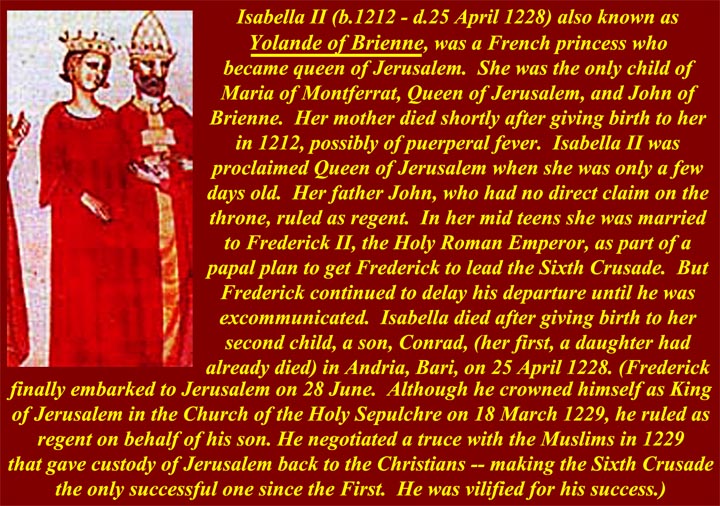 |
|
1222 |
Death of
Theodore I Lascaris, founder of the Byzantine
Empire of Nicaea. He is
succeeded by John III Ducas Vatatzes. |
|
|
1223 |
Pagans from
the island of Saaremaa revolt against new
Christian leaders, recapturing most of Estonia.
They would lose it all again by the next year. |
|
|
July 14, 1223 |
Philip II
Augustus of France dies. Philip had been one of
the leaders of the Third Crusade
and leaves an inheritance of 50,000 marks to the
Latin Kingdom of Jerusalem. |
|
|
1224 |
Amaury de
Montfort, leader of the Crusade against the
Cathars, flees Carcassonne. The son of
Raymond-Roger de Trencaval returns from exile and
reclaims the area. |
|
|
October 1225 |
Yolanda, Queen
of Jerusalem.
arrives in Brindisi with her father, John of
Brienne, for her marriage to Frederick II of
Hohenstaufen. |
|
|
November 1225 |
Raymond, son
of Raymond of Toulouse, is excommunicated. |
|
|
November 09, 1225 |
Frederick II
of Hohenstaufen marries Yolanda (Isabella) of Jerusalem.
daughter of John of Brienne, nominal king of Jerusalem.
Many expected this marriage to turn the tide in
Palestine against the Muslims.
For years the local barons had been selling off
their estates to the military monastic orders
which did little to press the Christian cause
against Islam. |
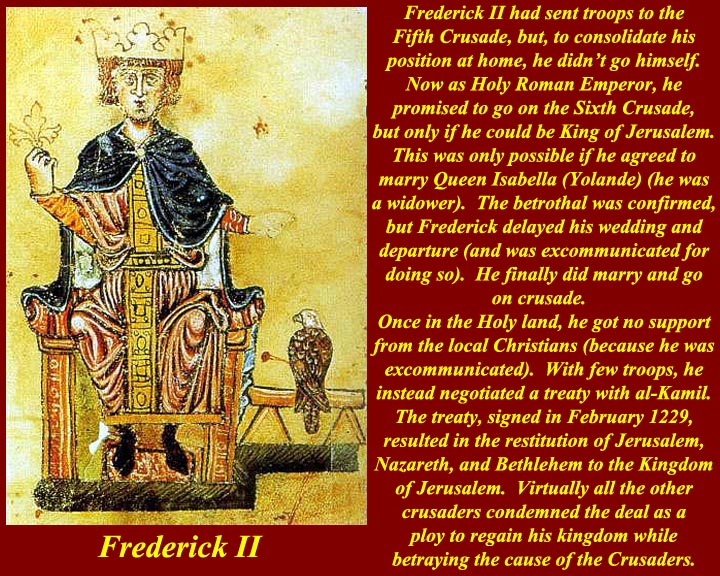 |
|
June 1226 |
The Crusade
against Cathars in southern France is renewed. |
|
|
1227 |
Medieval
theologian Thomas Aquinas
is born. Aquinas codified Catholic theology in
works like Summa Theologica, marking the high
point of the medieval scholastic movement. |
|
|
1227 |
Emperor
Frederick II of Hohenstaufen is excommunicated by
Pope Gregory IX
for having failed thus far to honor his promise to
launch the Sixth Crusade |
|
|
1228 - 1229 |
The Sixth Crusade is
led by Holy Roman Emperor
Frederick II of Hohenstaufen, King of Jerusalem
through his marriage to Yolanda, daughter of John
of Brienne, king of Jerusalem.
Frederick had promised to participate in the Fifth Crusade
but failed to do so, thus he was under a great
deal of pressure to do something substantive this
time around. This Crusade would end with a peace
treaty granting Christians control of several
important holy sites, including Jerusalem. |
|
|
1228 |
Baldwin II is
crowned emperor of the Latin Empire in Constantinople,
with John of Brienne as regent. |
|
| April 25, 1228 | While in
Palermo, Yolanda, Queen of Jerusalem.
gives birth to Conrad, son of Frederick II of
Hohenstaufen. The delivery is hard on the
sixteen-year-old and she dies a few days later. |
|
|
May 01, 1228 |
Death of
Yolanda, Queen of Jerusalem.
Yolanda was sixteen years old and had just given
birth to Conrad, son of German emperor Frederick
II. With her death, Jerusalem was
now ruled by Frederick alone, a man with no blood
ties to the first families that had captured Jerusalem and
the Holy Lands. In effect, Jerusalem was
now ruled by foreigners again. |
|
|
June 28, 1228 |
Emperor
Frederick II of Hohenstaufen officially (and
finally) sets forth on a Crusade. |
|
|
July 21, 1228 |
Emperor
Frederick II of Hohenstaufen arrives in Cyprus to
participate in the Sixth Crusade. An outbreak of
fever among the Crusaders forces Frederick to
return, but Pope Gregory IX
doesn't accept this as a valid reason - besides,
Gregory was looking for an excuse to punish
Frederick because for years he had been infringing
up on papal lands and power throughout Italy.
Frederick is excommunicated and a Crusade is
actually preached against him, with his lands
around Naples occupied by the pope. |
|
|
1229 |
The Teutonic
Order launches a Crusade to conquer Prussia. |
|
|
1229 - 1231 |
James I of
Aragon launches a Crusade in Spain, conquering
Valencia and the Balearic Islands. |
|
|
1229 |
Death of
Albert, the third Bishop of Buxtehude (Uexküll).
Albert had been a major driving force behind the
Baltic Crusade. |
|
|
February 18, 1229 |
Emperor
Frederick II of Hohenstaufen signs a treaty with
Sultan Malik Al-Kamil of Egypt and
thus acquires controls of Jerusalem.
Nazareth, and Bethlehem from Muslim forces.
Al-Kamil had been impressed with Frederick's
knowledge of Arabic language and culture, leading
to a mutual exchange of ideas and respect which
allowed the dramatic and unexpected peace treaty
to be signed. In exchange, Frederick agrees to
support Al-Kamil against his own nephew, al-Nasir.
Frederick had been essentially forced to negotiate
because at the time he had been excommunicated by
Pope Gregory IX
and most of the Crusaders in the region (for
example, Patriarch Gerald of Lausanne, the Knights Hospitaller,
and the Knights Templar)
simply failed to obey his commands. Gregory
refuses to accept the treaty as valid and doesn't
support it. |
|
|
March 18, 1229 |
Frederick II
crowns himself king of Jerusalem in
the Church of the Holy Sepulcher. Conrad IV of
Germany had become titular King of Jerusalem the
previous year with his father Frederick II as
regent. Frederick's wife, Yolanda of Jerusalem and
titular Queen of Jerusalem,
had died the previous year, so Frederick took the
crown for himself. |
|
| Events
after the Sixth Crusade |
||
|
April 12, 1229 |
A peace treaty
formally ends the Albigensian Crusade in
southern France. |
|
|
May 1229 |
Emperor
Frederick II of Hohenstaufen returns home and
regains control of his lands around Naples from Pope Gregory IX. |
|
|
August 1229 |
Emperor
Frederick II of Hohenstaufen arrives at a peace
treaty with Pope Gregory IX. |
|
|
November 1229 |
The
Inquisition is established in Toulouse to
eliminate the last of the Cathars hiding in the
Languedoc region. |
|
|
1230 |
Returning
Crusaders bring leprosy to Europe. |
|
|
1233 |
The
Inquisition launches a ruthless campaign against
the Cathars, burning any that they find and even
digging up bodies to burn. |
|
|
1234 |
The Teutonic Knights
arrive in the Baltic region to assist in fending
off invasions from pagan Prussians. |
|
|
1236 |
The city of
Cordova, controlled to the Moors, falls to the
Christian kingdom of Castile. |
|
|
1237 |
Death of John
of Brienne, former regent of Jerusalem and
Latin Emperor of Constantinople.
His successor is Baldwin II. |
|
|
1237 |
Batu Khan, son
of Ghengis Khan, crosses the Volga river with an
army of at least 150,000 horsemen. In short order
he conquers all of the Russian principalities and
defeats both the Hungarians and the Poles. Later
he would be stopped from marching right into the
heart of Europe only by the news of his father's
death, causing him to immediately return home. |
|
|
May 12, 1237 |
By decree of Pope Gregory IX,
the crusading order "The Swordbrothers" is merged
into the order,"The Teutonic Knights."
Both orders had been heavily involved in Crusades
against pagan Prussians; the Swordbrothers,
however, had experienced numerous defeats
(especially at the Battle of Saule in 1236) and
their growing weakness necessitated that they join
with the Teutonic Knights. |
|
|
1238 |
Malik
Al-Kamil, Sultan of Egypt and
nephew of Saladin,
dies. |
|
|
February 18, 1239 |
The truce
between Emperor Frederick II of Hohenstaufen and
Sultan Malik Al-Kamil, signed to end the Sixth
Crusade, officially ends. |
|
|
1240 |
Mongols
capture Moscow and destroy Kiev. |
|
|
1240 |
The Sultan of
Egypt agrees
to turn over control of all lands west of the Jordan
earlier captured by Saladin to
the Kingdom of Jerusalem. |
|
|
October 1240 |
Raymond-Roger
de Trencavel is defeated at Carcassonne by
Crusaders going after Cathars. |
|
|
1241 |
The first
person recorded to be hanged, drawn, and quartered
in England is pirate William Marise. |
|
|
April 09, 1241 |
Battle of Wahlstatt (Polish:
Legnickie Pole): A Crusade
against the Mongols is proclaimed after the Teutonic Knights
and Henry II the Pious, duke of Poland, are
defeated by the Mongols. Mongol leader Batu Khan,
son of Ghengis Khan, is only stopped from
continuing into the heart of Europe by the news of
his father's death, causing him to immediately
return home. |
|
|
April 05, 1242 |
Battle on Lake Peipus (Chudskoye):
Russian forces under Prince Alexander Nevsky
utterly defeat an army of Teutonic Knights
on the frozen Lake Peipus. |
|
|
1243 |
The Sultan of
Syria and Egypt offers
to withdraw Muslims from the Temple Mount area in
Jerusalem in
order to get the Franks to support him. |
|
|
March 16, 1244 |
Montsegur, the
largest Cathar
stronghold, falls after a nine month siege. |
|
|
July 11, 1244 |
Khorezmian
Turkish horsemen launch an attack on Jerusalem.
Khwarezmia is at this time a state located around
the Aral Salt Flats near the Caspian Sea. |
|
|
August 23, 1244 |
Jerusalem
falls to the Khorzmian horsemen who had begun
attacking the city the previous month. Large
numbers of the city's inhabitants are slaughtered. |
|
|
October 17, 1244 |
Battle of LaForbie: A large army
of Crusaders is utterly destroyed by Muslims near
Gaza. Egyptian forces are commanded by Baibars, a
Mamluk soldier who would later lead a revolt
against the Egyptian Sultan and take control of
the region. |
|
Seventh,
Eighth, and Ninth Crusades 1245 - 1300
From:
http://atheism.about.com/library/FAQs/christian/blchron_xian_crusades11.htm
Led by King
Louis IX of France, the Seventh and Eighth
Crusades were complete failures. In the Seventh
Crusade Louis sailed to Egypt in 1248 and
recaptured Damietta, but after he and his army
were routed he had to return it as well as a
massive ransom just to get free. In 1270 he set
off on the Eighth Crusade, landing in North
Africa in the hope of converting the sultan of
Tunis to Christianity but died before he got
far.
Led by King Edward I of England in
1271 who tried to join Louis in Tunis, the Ninth
Crusade would fail in the end. Edward arrived
after Louis had died and moved against the
Mamluk sultan Baibers. He didn't achieve much,
though, and returned home to England after he
learned that his father Henry III had died.
|
Seventh,
Eighth, and Ninth Crusades 1245 - 1300 |
||||||||||||||||||||||||||||||||||||||||
|
July 11, 1244 |
Khorezmian
Turkish horsemen launch an attack on Jerusalem.
Khwarezmia is at this time a state located
around the Aral Salt Flats near the
Caspian Sea. |
|||||||||||||||||||||||||||||||||||||||
|
August 23,
1244 |
Jerusalem
falls to the Khorzmian horsemen who had
begun attacking the city the previous
month. Large numbers of the city's
inhabitants are slaughtered. |
|||||||||||||||||||||||||||||||||||||||
|
October 17,
1244 |
Battle of LaForbie: A large army
of Crusaders is utterly destroyed by Muslims
near Gaza. Egyptian forces are commanded
by Baibars, a Mamluk soldier who would
later lead a revolt against the Egyptian
Sultan and take control of the region. |
|||||||||||||||||||||||||||||||||||||||
|
1245 |
King Louis IX
of France (Saint Louis) declares his
intent to launch a Crusade against the
Muslims in the Middle East. By this point
the Crusade against the Cathars in
southern France is basically over and his
relative Alphonse was in charge in
Toulouse. |
|||||||||||||||||||||||||||||||||||||||
|
1247 |
Traditional
date for the death of Robin Hood. |
|||||||||||||||||||||||||||||||||||||||
|
1247 |
||||||||||||||||||||||||||||||||||||||||
|
1248 |
Muslim control
of Spain is reduced to the Kingdom of
Granada which survives for over two more
centuries. |
|||||||||||||||||||||||||||||||||||||||
|
1248 - 1254 |
The Seventh Crusade
is led by King Louis IX of France (Saint
Louis). The Great Khan even sends
representatives to Louis to let him know
that he is willing to help in the conquest
of the Holy Land and the restoration of Jerusalem
to Christian control - in reality, though,
the Mongols were negotiating with both
sides and had no intention of helping
anyone. In this, his first of two
Crusades, Louis would end up capturing the
Egyptian city of Damietta, but it was
given up as ransom when he himself was
captured during the battle for Cairo. |
|||||||||||||||||||||||||||||||||||||||
|
November 23,
1248 |
Ferdinand III
of Castile captures Seville, Spain. Muslim
control of Spain is reduced to the Kingdom
of Granada which would survive for over
two more centuries. |
|||||||||||||||||||||||||||||||||||||||
|
June 06, 1249 |
King Louis IX
of France reaches and occupies the
Egyptian city of Damietta. Louis focuses
first and foremost on Egypt
rather than sites in Syria
because he hopes that this will provide a
solid base from which to attack the rest
of the Holy Land. |
|||||||||||||||||||||||||||||||||||||||
|
November 1249 |
King Louis IX
of France begins to march his troops from
Damietta to Cairo. |
|||||||||||||||||||||||||||||||||||||||
|
February 08,
1250 |
Battle of al-Mansurah: Crusaders led
by King Louis IX of France move from
Damietta to Cairo along the Nile River
until they meet Emir Fakr-ed-din at the
head of a army of 70,000 at Ashmoun Canal
by the town of al-Mansurah.
This is the same spot where the Fifth Crusade
had met defeat. After a standoff of six
weeks, a local Coptic Christian shows the
Crusaders a way to cross the canal and in
a surprise attack they route the Egyptians
still in their encampment. Unfortunately,
the French choose to follow the fleeing
Egyptians to al-Mansurah
despite the lack of reinforcements and
they suffer heavy casualties in the
process. Robert of Artois (brother of
Louis IX) and William of Salisbury
(leading an English force) are both killed
along with most of the Knights Templar
who had followed them. |
|||||||||||||||||||||||||||||||||||||||
|
April 06, 1250 |
Battle of Fariskur: King Louis IX is
captured along with his
army and ransomed in exchange for the
surrender of Damietta - the only real
achievement of the Crusade. Louis is lucky
to be released at all because the
difficulty with caring for the large
numbers of prisoners led to the Egyptians
executing many of them. This is the final
battle in the Seventh Crusade. |
|||||||||||||||||||||||||||||||||||||||
|
May 1250 |
Turanshah, the
last Ayyubid Sultan of Egypt
in a dynasty founded by Saladin,
is murdered and replaced by his Mamluk
slave-general Aibek, founder the Mamluk
Dynasty. King Louis IX would actually form
an alliance with the Mamluks shortly after
this. The word "Mamluk" literally means
"one who is owned," or "slave," a
reference to the fact that the Mamluks
started out as slaves. |
|||||||||||||||||||||||||||||||||||||||
|
1251 |
The last of
the Egyptian-based dynasties, the Mamluk
dynasty, took over the caliphate until
1517 when Egypt
fell under the control of the Ottoman Turkish
Empire. |
|||||||||||||||||||||||||||||||||||||||
|
1251 |
The "Crusade
of the Shepherds" is launched. |
|||||||||||||||||||||||||||||||||||||||
|
1251 |
The last of
the Egyptian-based dynasties, the Mamluk
dynasty, takes over the caliphate until
1517 when Egypt falls under the control of
the Ottoman
Turkish Empire. |
|||||||||||||||||||||||||||||||||||||||
|
1252 |
The Teutonic Knights
capture the Lithuanian city of Klaipeda
from local pagans. Lithuania would be
access to the Baltic Sea until the 20th
century. |
|||||||||||||||||||||||||||||||||||||||
|
1253 |
Pagan leader
Mindaugas of Lithuania agrees to convert
to Christianity. |
|||||||||||||||||||||||||||||||||||||||
|
1253 |
Friar William
of Rubruck visits the court of the Great
Mongol Khan Mongke, creating a detailed
description of Mongol customs and beliefs
before their conversion to Islam. |
|||||||||||||||||||||||||||||||||||||||
|
November 03,
1254 |
Death of John
III Ducas Vatatzes, Byzantine
emperor (Empire of Nicaea).
He is succeeded by Theodore II Lascaris. |
|||||||||||||||||||||||||||||||||||||||
|
1255 |
The Teutonic Knights
build their stronghold of Königsberg. |
|||||||||||||||||||||||||||||||||||||||
|
May 1255 |
The last Cathar
stronghold - an isolated fort at Quéribus
- is captured. |
|||||||||||||||||||||||||||||||||||||||
|
January 1256 |
Hulagu, son of
the Great Khan, wipes out the Assassins of
Persia. |
|||||||||||||||||||||||||||||||||||||||
|
1258 |
Birth of
Osman, founder of the Ottoman
Turkish Empire. His father was Etrogrul,
commander of a tribe of Oghuz Turks near
the Sea of Marmara. |
|||||||||||||||||||||||||||||||||||||||
|
February 10,
1258 |
The Abbasid
period ends with the destruction of
Baghdad by the Mongols. The Mongols had
tried and failed to take Baghdad in 1245.
Now, after a series of devastating floods,
the city's defenses had been weakened, and
Hülegü, grandson of Genghis Khan, leads
the victorious invasion - one which kills
an estimated 800,000 citizens of the city.
Thus begins a long period of economic,
political, and cultural decline in Iraq
that is only overcome in the sixteenth
century. |
|||||||||||||||||||||||||||||||||||||||
|
August 1258 |
Death of
Theodore II Lascaris, Byzantine
emperor (Empire of Nicaea).
He is succeeded by John IV Lascaris, just
eight years old. Michael Palaeologus is
made regent and later he makes himself
co-emperor as Michael VIII. |
|||||||||||||||||||||||||||||||||||||||
|
1259 |
The Great Khan
dies. |
|||||||||||||||||||||||||||||||||||||||
|
1259 |
Battle of Pelagonia: Greek forces
defeat the Latins of Achaea. |
|||||||||||||||||||||||||||||||||||||||
|
1260 |
Battle of Durbe: Lithuanians defeat the
Livonian Teutonic Knights |
|||||||||||||||||||||||||||||||||||||||
|
September 03,
1260 |
Battle of Ain Jalut: The Mamluks
of Egypt
defeat the invading Mongols, thus
preventing any further Mongol advance into
Egypt and North Africa. |
|||||||||||||||||||||||||||||||||||||||
|
October 23,
1260 |
Baibars, a
Mamluk leader, is named Sultan of Egypt. |
|||||||||||||||||||||||||||||||||||||||
|
July 25, 1261 |
Michael VIII
Palaeologus (1224 - 1282) finally drives
the Latin rulers out of Constantinople
and reestablishes Eastern Orthodox
rule after 50 years. To solidify his own
position he has John IV Lascaris, last of
the Lascaris line and his co-emperor,
blinded and thus rendered ineligible to
become emperor. |
|||||||||||||||||||||||||||||||||||||||
|
1263 |
Mindaugas,
first and only Christian king of
Lithuania, is assassinated by his pagan
cousin Treniota. |
|||||||||||||||||||||||||||||||||||||||
|
1265 |
Dante Dante
Alighieri is born. |
|||||||||||||||||||||||||||||||||||||||
|
1265 |
Baibars,
Mamluk Sultan of Egypt,
captures Caesarea and Haifa. |
|||||||||||||||||||||||||||||||||||||||
|
February 26,
1266 |
The Battle
of Benevento takes place. |
|||||||||||||||||||||||||||||||||||||||
|
1267 |
Kublai Kahn
establishes the city of Beijing. |
|||||||||||||||||||||||||||||||||||||||
|
1267 |
King Louis IX
of France, disturbed by the many gains of
the Mamluks in Egypt,
calls for a new Crusade. |
|||||||||||||||||||||||||||||||||||||||
|
1268 |
||||||||||||||||||||||||||||||||||||||||
|
May 18, 1268 |
The Mamluks of
Egypt
under the command of Sultan Baibars take
the city of Antioch
and kill most of its inhabitants. The
physical destruction of the city is so
extensive that it would never again play
an important strategic or commercial role
in the region, eventually being overtaken
by the port city of Alexandretta
(Iskenderun). |
|||||||||||||||||||||||||||||||||||||||
|
August 23,
1268 |
The Battle
of Tagliacozzo occurs. |
|||||||||||||||||||||||||||||||||||||||
|
Seventh Crusade 1248
- 1254 From
Wikipedia
http://en.wikipedia.org/wiki/Seventh_Crusade
Background The Seventh
Crusade was a crusade
led by Louis IX
of France from 1248 to
1254. Approximately 800,000 bezants
were paid in ransom for King Louis who,
along with thousands of his troops, was
captured and defeated by the Egyptian
army led by the Ayyubid Sultan Turanshah
supported by the Bahariyya
Mamluks
led by Faris
ad-Din Aktai, Baibars
al-Bunduqdari, Qutuz,
Aybak
and Qalawun.[3][4][5] In 1244, the
Khwarezmians,
recently displaced by the advance of the
Mongols, took Jerusalem
on their way to ally with the Egyptian Mamluks.
This returned Jerusalem to Muslim
control, but the fall of
Jerusalem was no longer
an earth-shattering event to European
Christians,
who had seen the city pass from
Christian to Muslim
control numerous times in the past two
centuries. This time, despite calls from
the Pope, there was no popular
enthusiasm for a new crusade. Pope
Innocent IV and Frederick
II, Holy Roman Emperor
continued the papal-imperial struggle.
Frederick had captured and imprisoned
clerics on their way to the First
Council of Lyon, and in
1245 he was formally deposed by Innocent
IV. Pope
Gregory IX had also
earlier offered King Louis' brother,
count Robert of
Artois, the German
throne, but Louis had refused. Thus, the
Holy
Roman Emperor was in no
position to crusade. Béla IV
of Hungary was rebuilding
his kingdom from the ashes after the
devastating Mongol invasion of 1241. Henry
III of England was still
struggling with Simon de
Montfort and other
problems in England.
Henry and Louis were not on the best of
terms, being engaged in the Capetian-Plantagenet
struggle, and while Louis was away on
crusade the English king signed a truce
promising not to attack French lands.
Louis IX had also invited King Haakon IV
of Norway to crusade,
sending the English chronicler Matthew
Paris as an ambassador,
but again was unsuccessful. The only man
interested in beginning another crusade
therefore was Louis IX, who declared his
intent to go East in 1245. Fighting France was
perhaps the strongest state in Europe at
the time, as the Albigensian
Crusade had brought Provence
into Parisian
control. Poitou
was ruled by Louis IX's brother Alphonse
of Poitiers, who joined
him on his crusade in 1245. Another
brother, Charles I
of Anjou, also joined
Louis. For the next three years Louis
collected an ecclesiastical tenth
(mostly from church
tithes),
and in 1248 he and his approximately
15,000-strong army that included 3,000
knights, and 5,000 crossbowmen sailed on
36 ships from the ports of Aigues-Mortes,
which had been specifically built to
prepare for the crusade, and Marseille.[2] Louis IX's financial
preparations for this expedition were
comparatively well organized, and he was
able to raise approximately 1,500,000 livres
tournois. However, many nobles who
joined Louis on the expedition had to
borrow money from the royal treasury,
and the crusade turned out to be very
expensive. They sailed
first to Cyprus
and spent the winter on the island,
negotiating with various other powers in
the east; the Latin
Empire set up after the Fourth
Crusade asked for his
help against the Byzantine
Empire of
Nicaea, and the Principality
of Antioch and the Knights
Templar wanted his help
in Syria,
where the Muslims had recently captured
Sidon. Nonetheless,
Egypt
was the object of his crusade, and he
landed in 1249 at Damietta
on the Nile.
Egypt would, Louis thought, provide a
base from which to attack Jerusalem, and
its wealth and supply of grain would
keep the crusaders fed and equipped. On June 6
Damietta was taken with little
resistance from the Egyptians, who
withdrew further up the Nile.
The flooding of the Nile had not been
taken into account, however, and it soon
grounded Louis and his army at Damietta
for six months, where the knights sat
back and enjoyed the spoils of war.
Louis ignored the agreement made during
the Fifth
Crusade that Damietta
should be given to the Kingdom
of Jerusalem, now a rump
state in Acre, but he did set up an
archbishopric there (under the authority
of the Latin
Patriarch of Jerusalem)
and used the city as a base to direct
military operations against the Muslims
of Syria. The fifteenth century Muslim
historian al-Maqrizi
portrays Louis IX as sending a letter to
as-Salih Ayyub that said : As you know
that I am the ruler of the Christian
nation I do know you are the ruler of
the Muhammadan nation. The people of Andalusia
give me money and gifts while we drive
them like cattle. We kill their men and
we make their women widows. We take the
boys and the girls as prisoners and we
make houses empty. I have told you
enough and I have advised you to the
end, so now if you make the strongest
oath to me and if you go to Christian
priests and monks and if you carry
kindles before my eyes as a sign of
obeying the cross, all these will not
persuade me from reaching you and
killing you at your dearest spot on
earth. If the land will be mine then it
is a gift to me. If the land will be
yours and you defeat me then you will
have the upper hand. I have told you and
I have warned you about my soldiers who
obey me. They can fill open fields and
mountains, their number like pebbles.
They will be sent to you with swords of
destruction.[6] In November,
Louis marched towards Cairo,
and almost at the same time, the Ayyubid
sultan
of Egypt, as-Salih
Ayyub, died. A force led
by Robert of
Artois and the Templars
attacked the Egyptian camp at Gideila
and advanced to Al
Mansurah where they were
defeated at the Battle of
Al Mansurah, and Robert
was killed. Meanwhile, Louis' main force
was attacked by the Mameluk
Baibars,
the commander of the army and a future
sultan himself. Louis was defeated as
well, but he did not withdraw to
Damietta for months, preferring to
besiege Mansourah, which ended in
starvation and death for the crusaders
rather than the Muslims. In showing
utter agony, a Templar knight
lamented : Rage and
sorrow are seated in my heart...so
firmly that I scarce dare to stay alive.
It seems that God wishes to support the
Turks to our loss...ah, lord God...alas,
the realm of the East has lost so much
that it will never be able to rise up
again. They will make a Mosque
of Holy Mary's convent, and since the
theft pleases her Son, who should weep
at this, we are forced to comply as
well...Anyone who wishes to fight the
Turks is mad, for Jesus
Christ does not fight
them any more. They have conquered, they
will conquer. For every day they drive
us down, knowing that God, who was
awake, sleeps now, and Muhammad
waxes powerful.[7] In March 1250
Louis finally tried to return to
Damietta, but he was taken captive at
the of Battle of
Fariskur where his army
was annihilated. Louis fell ill with
dysentery, and was cured by an Arab
physician. In May he was ransomed for
800,000 bezants, half of which was to be
paid before the King left Egypt, with
Damietta also being surrendered as a
term in the agreement. Upon this, he
immediately left Egypt for Acre,
one of few remaining crusader
possessions in Syria.[8][9] Aftermath Louis made an
alliance with the Mamluks, who at the
time were rivals of the Sultan
of Damascus, and from his
new base in Acre began to rebuild the
other crusader cities, particularly Jaffa
and Saida.[10] Although the Kingdom
of Cyprus claimed
authority there, Louis was the de
facto ruler. In 1254 Louis' money
ran out, and his presence was needed in
France where his mother and regent Blanche
of Castile had recently
died. Before leaving he established a
standing French garrison at Acre, the
capital of the Kingdom of Jerusalem
after the loss of Jerusalem, at the
expense of the French crown, it remained
there until the fall of
Acre in 1291.[11]
His crusade was a failure, but he was
considered a saint
by many, and his fame gave him an even
greater authority in Europe than the Holy
Roman Emperor. In 1270 he
attempted another
crusade, though it too
would end in failure. The history
of the Seventh Crusade was written by Jean
de Joinville, who was
also a participant, Matthew
Paris and many Muslim
historians. Literary
response The failure
of the Seventh Crusade engendered
several poetic responses from the Occitan
troubadours.
Austorc
d'Aorlhac, composing
shortly after the Crusade, was surprised
that God would allow Louis IX to be
defeated, but not surprised that some Christians
would therefore convert to Islam. In a slightly
later poem, D'un sirventes m'es gran
voluntatz preza, Bernart
de Rovenac attacks both James
I of Aragon and Henry III
of England for neglecting
to defend "their fiefs" that the rei
que conquer Suria ("king who
conquered Syria") had possessed. The
"king who conquered Syria" is a mocking
reference to Louis, who was still in
Syria (1254) when Bernart was writing,
probably in hopes that the English and
Aragonese kings would take advantage of
the French monarch's absence. Bertran
d'Alamanon criticized Charles
of Anjou's neglect of Provence in favor
of crusading. He wrote one of his last
works, which bemoans Christendom's
decline overseas, between the Seventh
and Eighth Crusades (1260–1265). References 1.
^ Hinson, p.393 2.
^ a b J. Riley-Smith, The
Crusades: A History, 193 3.
^ Abu
al-Fida 4.
^ Al-Maqrizi 5.
^ Ibn Taghri 6.
^ Al-Maqrizi, p. 436/vol.1 7.
^ Howarth,p.223 8.
^ Watterson, Barbara. The
Egyptians. Blackwell
Publishing, 1998. page 261 9.
^ Al-Maqrizi 10. ^ Joinville and
Villehardouin: Chronicles of the
Crusades, translated by
M.R.B. Shaw, pages 295-316,
Penguin Classics: New York, 1963 09 Primary sources ·
Abu
al-Fida, The
Concise History of Humanity. ·
Al-Maqrizi,
Al Selouk Leme'refatt Dewall
al-Melouk, Dar al-kotob, 1997. In
English: Bohn, Henry G., The Road to
Knowledge of the Return of Kings,
Chronicles of the Crusades, AMS Press,
1969 · Ibn
Taghri, al-Nujum
al-Zahirah Fi Milook Misr wa
al-Qahirah, al-Hay'ah al-Misreyah 1968 · Jean de Joinville, Histoire
de Saint Louis, 1309 Secondary sources ·
Keen, Maurice (editor). Medieval
Warfare. Oxford University
Press, 1999. ISBN
0-19-820639-9 ·
Konstam, Angus (2002). Historical
Atlas of The Crusades. Thalamus
Publishing. |
||||||||||||||||||||||||||||||||||||||||
|
|
||||||||||||||||||||||||||||||||||||||||
|
1269 |
The Almohad (al-Muwahhidun)
Dynasty falls. Taking the name "the
Unitarians," this was a group of Berber
Muslims which had supplanted the
Almoravid (al-Murabitun) Dynasty in 1147
and was inspired by the teachings of
reformist Berber scholar Ibn Tumart. |
|||||||||||||||||||||||||||||||||||||||
|
June
30, 1270 |
King Louis IX of France (Saint
Louis) leads the Eighth Crusade (his
second Crusade) as an attack against
Tunisia. |
|||||||||||||||||||||||||||||||||||||||
|
August
25, 1270 |
King
Louis IX of France dies in Tunisia while
on the Eighth Crusade, his second
Crusade. He is reluctantly replaced by
his brother Charles of Anjou, King of
Sicily. |
|||||||||||||||||||||||||||||||||||||||
|
Eighth Crusade From
Wikipedia
http://en.wikipedia.org/wiki/Eighth_Crusade
The Eighth
Crusade was a crusade
launched by Louis IX,
King of
France, in 1270. The
Eighth Crusade is sometimes counted as
the Seventh, if the Fifth
and Sixth
Crusades of Frederick
II are counted as a
single crusade. The Ninth
Crusade is sometimes also
counted as part of the Eighth. Louis was
disturbed by events in Syria,
where the Mamluk
sultan
Baibars
had been attacking the remnant of the Crusader
states. Baibars had
seized the opportunity after a war
pitting the cities of Venice
and Genoa
against each other (1256–1260) had
exhausted the Syrian ports that the two
cities controlled. By 1265 Baibars had
captured Nazareth,
Haifa,
Toron,
and Arsuf.
Hugh III
of Cyprus, nominal king of
Jerusalem, landed in Acre
to defend that city, while Baibars
marched as far north as Armenia,
which was at that time under Mongol
control. These events
led to Louis' call for a new crusade in
1267, although there was little support
this time; Jean de
Joinville, the chronicler
who accompanied Louis on the Seventh
Crusade, refused to go.
Louis was soon convinced by his brother
Charles of Anjou
to attack Tunis
first, which would give them a strong
base for attacking Egypt,
the focus of Louis' previous
crusade as well as the Fifth
Crusade before him, both
of which had been defeated there.
Charles, as King of
Sicily, also had his own
interests in this area of the Mediterranean.
The Khalif
of Tunis, Muhammad
I al-Mustansir, also had
connections with Christian Spain and was
considered a good candidate for
conversion. In 1270 Louis landed on the
African coast in July, a very
unfavourable season for landing. Much of
the army became sick because of poor
drinking water, his Damietta
born son John Sorrow died on August 3
and on August 25[1] Louis himself died from a
"flux in the stomach", one day after the
arrival of Charles. His dying word was
"Jerusalem." Charles proclaimed Louis'
son Philip
III the new king, but
because of his youth Charles became the
actual leader of the crusade. Because of
further diseases the siege of Tunis was
abandoned on October 30 by an agreement
with the sultan. In this agreement the
Christians gained free trade with Tunis,
and residence for monks and priests in
the city was guaranteed, so the crusade
could be regarded as a partial success.
After hearing of the death of Louis and
the evacuation of the crusaders from
Tunis, Sultan Baibars
of Egypt cancelled his plan to send
Egyptian troops to fight Louis in Tunis.[2] Charles now allied himself
with Prince
Edward of England, who
had arrived in the meantime. When
Charles called off the attack on Tunis,
Edward continued on to Acre,
the last crusader outpost in Syria. His
time spent there is often called the Ninth
Crusade. Attendant
literature Bertran
d'Alamanon, a diplomat in the
service of Charles of Anjou, and Ricaut
Bonomel, a Templar in the
Holy Land, both composed songs around
1265. Bertran criticised the decline of
Christianity in Outremer, while Bonomel
criticised the Papal policy of pursuing
wars in Italy with money that should
have gone overseas. The failure
of the Eighth Crusade, like those of its
predecessors, caused a response to be
crafted in Occitan
poetry by the troubadours.
The death of Louis of France especially
sparked their creative output, notable
considering the hostility which the
troubadours had had towards the French
monarchy during the Albigensian
Crusade. Three planhs,
songs of lament, were composed for the
death of Louis IX. Guilhem
d'Autpol composed Fortz
tristors es e salvaj'a retraire
for Louis. Raimon
Gaucelm de Bezers
composed Qui vol aver complida
amistansa to celebrate the
preparations of the Crusade in 1268,
but in 1270 he had to compose Ab
grans trebalhs et ab grans marrimens
in commemoration of the French king. Austorc
de Segret composed No
sai quim so, tan sui desconoissens,
a more general Crusading
song, that laments
Louis but also that either God or the
Satan is misleading Christians. He
also attacks Louis's brother Charles,
whom he calls the caps e guitz
(head and guide) of the infidels,
because he convinced Louis to attack
Tunis and not the Holy
Land, and he
immediately negotiated a peace with
the Muslims after Louis's death. After the
Crusade, the aged troubadour Peire
Cardenal wrote a song, Totz
lo mons es vestitiz et abrazatz,
encouraging Louis's heir, Philip III, to
go to the Holy Land to aid Edward
Longshanks. Satiric
verses were composed in Tunis about
Louis new plan to invade Tunis: "O
Louis, Tunis is the sister of Egypt!
thus expect your ordeal! you will find
your tomb here instead of the house of
Ibn Lokman; and the eunuch Sobih will
be here replaced by Munkir and
Nakir.".[3] Notes 1.
^ John
Sorrow (in French Jean Tristan) was
born in Damietta, Egypt on April 8,
1250 during the Seventh Crusade. 2.
^
Al-Maqrizi, p. 69/vol.2 3.
^ Verses by a contemporary
Tunesian named Ahmad Ismail Alzayat
(Al-Maqrizi, p.462/vol.1) – House of
Ibn Lokman was the house in Al
Mansurah where Louis was imprisoned in
chains after he was captured in
Fariskur during the 7th crusade he was
under the guard of a eunuch named
Sobih. According to Muslim creed
Munkir and Nakir are two angels who
interrogate the dead. References · Al-Maqrizi,
Al Selouk Leme'refatt Dewall
al-Melouk, Dar al-kotob, Cairo
1997. ·
Idem in English: Bohn, Henry
G., The Road to Knowledge of the
Return of Kings, Chronicles of the
Crusades, AMS Press, 1969. ·
Richard, Jean: The
Crusades, C.1071-c.1291,
Cambridge University Press, 1999. ISBN
0-521-62566-1 ·
Throop, Palmer A., "Criticism
of Papal Crusade Policy in Old
French and Provençal."
Speculum,
Vol. 13, No. 4. (Oct., 1938), pp.
379–412. ·
Lyric
allusions to the crusades and the
Holy Land ·
Beebe,
Bruce, "The English Baronage and the
Crusade of 1270," in Bulletin of
the Institute of Historical Research,
vol. xlviii (118), November 1975,
pp. 127–148. ·
|
|
|||||||||||||||||||||||||||||||||||||||
|
1271 |
Marco Polo sets off to visit
the court of Kublai Khan (grandson of
Genghis Khan). |
|||||||||||||||||||||||||||||||||||||||
|
1271 -
1272 |
King Edward I of England
launches the Ninth Crusade against
Mamluk sultan Baibers. Edward had
travelled to Tunis to join Louis IX but
arrived too late, so continued into the
Holy Land on his own. |
|||||||||||||||||||||||||||||||||||||||
|
1271 |
Thomas
Agni of Cosenza becomes the Latin
Patriarch of Jerusalem. |
|||||||||||||||||||||||||||||||||||||||
|
April
08, 1271 |
Mamluk sultan Baibars conquers
the Krak des
Chevaliers, headquarters
of the Knights
Hospitaller in Syria. |
|||||||||||||||||||||||||||||||||||||||
|
November
21, 1272 |
Edward
returns home to England when he hears
that his father Henry III has died. |
|||||||||||||||||||||||||||||||||||||||
|
Ninth Crusade 1271
- 1272
The Ninth
Crusade, which is sometimes
grouped with the Eighth
Crusade, is commonly
considered to be the last major medieval
Crusade
to the Holy
Land. It took place in
1271–1272. Louis IX
of France's failure to
capture Tunis
in the Eighth
Crusade led Prince
Edward of England to sail
to Acre
in what is known as the Ninth Crusade.
The Ninth Crusade saw several impressive
victories for Edward over Baibars.
Ultimately the Crusade did not so much
fail as withdraw, since Edward had
pressing concerns at home and felt
unable to resolve the internal conflicts
within the remnant Outremer territories.
It is arguable that the Crusading spirit
was nearly "extinct," by this period as
well.[2] It also foreshadowed the
imminent collapse of the last remaining
crusader strongholds along the
Mediterranean coast. Prologue Following the
Mamluk victory over the Mongols
in 1260 at the Battle of
Ain Jalut by Qutuz
and his general Baibars,
Qutuz was assassinated, leaving Baibars
to claim the sultanate for himself. As
Sultan, Baibars proceeded to attack the
Christian crusaders at Arsuf,
Athlith,
Haifa,
Safad,
Jaffa,
Ascalon,
and Caesarea.
As the Crusader fortress cities fell one
by one, the Christians sought help from
Europe, but assistance was slow in
coming. In 1268
Baibars captured Antioch,
thereby destroying the last remnant of
the Principality
of Antioch, securing the
Mamluk northern front and threatening
the small Crusader County of
Tripoli. Louis IX of France, having already organized a large crusader army with the intent of attacking Egypt, was diverted rrived in Tunis too late to contribute to the remainder of the crusade in Tunis. Instead, he continued on his way to the Holy Land to assist Bohemund VI, Prince of Antioch and Count of Tripoli, against the Mamluk threat to Tripoli and the remnant of the Kingdom of Jerusalem.Crusader operations in the
Holy Land It was
decided that Edward along with Louis'
brother Charles
of Anjou would take their
forces onward to Acre, capital of the
remnant of the Kingdom of Jerusalem and
the final objective of Baibars'
campaign. The army of Edward and Charles
arrived in 1271, just as Baibars was
besieging Tripoli,
which as the last remaining territory of
the County of Tripoli was full of tens
of thousands of Christian refugees. From
their bases in Cyprus and Acre, Edward
and Charles managed to attack Baibars'
interior lines and break the siege. As soon as
Edward arrived in Acre, he made some
attempts to form a Franco-Mongol
alliance, sending an
embassy to the Mongol
ruler of Persia
Abagha,
an enemy of the Muslims. The embassy was
led by Reginald Rossel, Godefroi of Waus
and John of Parker, and its mission was
to obtain military support from the
Mongols.[3] In an answer dated
September 4, 1271, Abagha agreed for
cooperation and asked at what date the
concerted attack on the Mamluks should
take place. The arrival
of the additional forces from England
and Hugh III of Cyprus, under the
command of Edward's younger brother Edmund
emboldened Edward, who engaged in a raid
on the town of Qaqun.
At the end of
October 1271, a small force of Mongols
arrived in Syria and ravaged the land
from Aleppo
southward. However Abagha, occupied by
other conflicts in Turkestan
could only send 10,000 Mongol horsemen
under general Samagar
from the occupation army in Seljuk
Anatolia,
plus auxiliary Seljukid troops. Despite
the relatively small force though, their
arrival still triggered an exodus of
Muslim populations (who remembered the
previous campaigns of Kithuqa)
as far south as Cairo.[4] But the
Mongols did not stay, and when the
Mamluk leader Baibars mounted a
counter-offensive from Egypt on November
12, the Mongols had already retreated
beyond the Euphrates. In the
interim, Baibars came to suspect there
would be a combined land-sea attack on
Egypt. Feeling his position sufficiently
threatened, he endeavoured to head off
such a maneuver by building a fleet.
Having finished construction of the
fleet, rather than attack the Crusader
army directly, Baibars attempted to land
on Cyprus
in 1271, hoping to draw Hugh III
of Cyprus (the nominal King
of Jerusalem) and his
fleet out of Acre, with the objective of
conquering the island and leaving Edward
and the crusader army isolated in the
Holy Land. However, in the ensuing naval
campaign the fleet was destroyed and
Baibars' armies were forced back. Following
this victory, Edward realized that to
create a force capable of retaking
Jerusalem it would be necessary to end
the internal unrest within the Christian
state, and so he mediated between Hugh
and his unenthusiastic knights
from the Ibelin
family of Cyprus. In parallel to the
mediation, Prince
Edward and King Hugh
began negotiating a truce with Sultan
Baibars; a 10 year, 10 month and 10 day
agreement was reached in May 1272, at
Caesarea. Almost immediately Prince
Edmund departed for England, while
Edward remained to see if the treaty
would hold. The following month, Baibars
attempted to assassinate Edward. Edward
killed the assassin but received a
festering wound from a poisoned dagger
in the process, further delaying
Edward's own departure. In September
1272, Edward departed Acre for Sicily
and, while recuperating on the island,
he first received news of the death of
his son John, and then a few months
later news of the death of his father.
In 1273 Edward started his homeward
journey via Italy, Gascony and Paris.
Edward finally reached England in the
summer of 1274, and was crowned King of
England on August 19, 1274. Aftermath Romantic
portrayal of the "Last Crusader".
Increasing Muslim victories and
Christian defeats led to the end of
the Crusades. Edward had been accompanied by
Theobald Visconti, who became Pope
Gregory X in 1271.
Gregory called for a new crusade
at the Council
of Lyons in 1274, but
nothing came of this. Meanwhile, new
fissures arose within the Christian
states when Charles
of Anjou took advantage
of a dispute between Hugh III,
the Knights
Templar, and the Venetians
in order to bring the remaining
Christian state under his control.
Having bought Mary of
Antioch's claims to the Kingdom
of Jerusalem, he attacked
Hugh III, causing a civil
war within the rump
kingdom. In 1277 Roger of
San Severino captured
Acre for Charles. Although the
internecine war within the crusaders'
ranks had proven debilitating, it
provided the opportunity for a single
commander to take control of the crusade
in the person of Charles. However, this
hope was dashed when Venice suggested a
crusade be called not against the
Mamluks but against Constantinople,
where Michael
VIII had recently
re-established the Byzantine
Empire and driven out the
Venetians. Pope Gregory would not have
supported such an attack, but in 1281 Pope
Martin IV assented to it;
the ensuing fiasco helped lead to the Sicilian Vespers
on March 31, 1282, instigated by Michael
VIII, and Charles was forced to return
home. This was the last expedition
launched against the Byzantines in
Europe or the Muslims in the Holy Land. The remaining
nine years saw an increase in demands
from the Mamluks,
including tribute, as well as increased
persecution of pilgrims, all in
contravention of the truce.
In 1289, Sultan Qalawun
gathered a large army and invested the
remnants of the county of Tripoli,
ultimately, laying siege to the capital
and taking it after a bloody assault.
The attack on Tripoli however was
particularly devastating to the Mamluks
as the Christian resistance reached
fanatical proportions and Qalawun lost
his eldest and most able son in the
campaign. He waited another two years to
regather his strength. In 1291, a
group of pilgrims from Acre came under
attack and in retaliation killed
nineteen Muslim merchants in a Syrian caravan. Qalawun demanded they pay
an extraordinary amount in compensation.
When no reply came, the Sultan used it
as a pretext to besiege
Acre, and finish off the
last independent Crusader
state occupying the Holy
Land. Qalawun died during the siege,[citation needed] leaving
Khalil, the sole surviving member of his
family, as Mamluk Sultan. With Acre
seized, the Crusader States ceased to
exist. The center of power of the
Crusaders was moved northwards to Tortosa,
and eventually offshore to Cyprus. In
1299, a Mongol army, led by Ghazan
Khan, led a series of
successful raids against the Mamluks in
an area
northeast of Homs,
to as far south into Gaza.
He, finally, withdrew from Syria, in
1300. The Mongols, and their Cilician
Armenian allies, led
another campaign to recapture Syria,
but were soon defeated by the Mamluks
at the Battle of
Shaqhab, in 1303. The
last remaining foothold on the Holy
Land, Ruad
Island, was lost
in 1302/1303. The period of the Crusades
to the Holy Land
was over, after 208 years since Pope
Urban II had called for
the first of these holy wars.
Notes 1.
^ The
Gospel in All Lands, Methodist Episcopal Church
Missionary Society, Methodist
Episcopal Church, p. 262 2.
^ A
Manual of Church History, Albert
Henry Newman, p. 461 3.
^ Histoire
des Croisades III, René
Grousset, p. 653. Grousset quotes a
contemporary source ("Eracles", p.
461) explaining that Edward contacted
the Mongols "por querre secors" ("To
ask for help"). 4.
^ Histoire
des Croisades III, René
Grousset, p. 653. References ▪ "Histoire des Croisades III",
René Grousset |
|
|||||||||||||||||||||||||||||||||||||||
|
October
1273 |
Death
of Baldwin II, the last emperor of the
Latin Empire of Constantinople.
Baldwin's reign had effectively ended
when Michael VIII Palaeologus recaptured
Constantinople in 1261, but European
leaders continued to recognize his
claim. Once he dies, however, the Latin
Empire of Constantinople also ceases to
exist. |
|||||||||||||||||||||||||||||||||||||||
|
1274 |
Mongols,
led by Kublai Khan, attempted to invade
Japan. |
|||||||||||||||||||||||||||||||||||||||
|
May
07, 1274 |
In
France the Second Council of Lyons opens.
|
|||||||||||||||||||||||||||||||||||||||
|
May
18, 1274 |
The Second Council of Lyon
issues its Crusade decree,
Constitutiones Pro Zelo Fidei. At this
same Council Michael VIII Palaeologus, Byzantine
Emperor, agreed to a unification of the
Eastern
Orthodox and Roman
Churches. |
|||||||||||||||||||||||||||||||||||||||
|
July
01, 1277 |
Baibars,
Sultan of Egypt,
dies. |
|||||||||||||||||||||||||||||||||||||||
|
September
1277 |
With the arrival of the Vicar
of Charles of Anjou in Acre, the Kingdom
of Jerusalem
is split. |
|||||||||||||||||||||||||||||||||||||||
|
1279 |
Syrian
leader Qalawun succeeds Baibars as
Sultan of Egypt. |
|||||||||||||||||||||||||||||||||||||||
|
1280 |
Eyeglasses
are invented and later improved upon in
the late medieval period. |
|||||||||||||||||||||||||||||||||||||||
|
1281 |
Qalawun,
Sultan of Egypt, defeats a Mongol army
near Homs. |
|||||||||||||||||||||||||||||||||||||||
|
1283 -
1302 |
A
Crusade against Sicilians and Aragonese
is launched. |
|||||||||||||||||||||||||||||||||||||||
|
1284 |
The
Teutonic
Knights complete their
conquest of Prussia, eliminating the
local Prussian population as an
independent ethnic group. The Prussians
would be assimilated by the Germans,
Poles, and Lithuanians while the
Prussian name would be adopted by the
Germans for themselves. |
|||||||||||||||||||||||||||||||||||||||
|
1285 |
French
forces launch a Crusade against Aragon. |
|||||||||||||||||||||||||||||||||||||||
|
June
04, 1286 |
The
Kingdom of Jerusalem
is reunited under the rule of King Henry
II of Cyprus. |
|||||||||||||||||||||||||||||||||||||||
|
April
26, 1289 |
Mamluks
from Egypt
capture the city of Tripoli. |
|||||||||||||||||||||||||||||||||||||||
|
1290 |
Margaret,
Maid of Norway, dies and leaves a
struggle for the throne of Scotland - 13
people claim title of King. |
|||||||||||||||||||||||||||||||||||||||
|
1290 |
Qalawun,
Sultan of Egypt, dies and is succeeded
by his son, Al-Ashraf Khalil. |
|||||||||||||||||||||||||||||||||||||||
|
May
18, 1291 |
Acre,
the last territory in Palestine taken by
the first
Crusaders, falls to
invading Muslim forces. Around 60,000
Christians are believed to have
perished. This is the end of a Christian
military presence in the Near East and
the task of spreading Christianity is
left to friars who preach among the
people. |
|||||||||||||||||||||||||||||||||||||||
|
July
1291 |
The
Mamluks capture Beirut and Sidon. |
|||||||||||||||||||||||||||||||||||||||
|
August
1291 |
Crusaders
are forced to evacuate their fortresses
at Tortosa and Chateau Pelerin. |
|||||||||||||||||||||||||||||||||||||||
|
1292 |
Birth
of John VI Cantacuzene, Byzantine
Emperor who would allow Turkish military
forces to first cross into Europe in
order to get their aid against a rival
for the Byzantine throne. |
|||||||||||||||||||||||||||||||||||||||
|
1295 |
Mongol
leader Ghazan Khan converts to Islam,
ending the line of Tantric Buddhist
rulers. |
|||||||||||||||||||||||||||||||||||||||
|
1296 |
Edward
I of England deposes John Balliol from
the Scottish throne, taking control of
Scotland. |
|||||||||||||||||||||||||||||||||||||||
|
1297 |
At
the Battle of Cambuskenneth, Scottish
patriot William Wallace defeats an
English army. |
|||||||||||||||||||||||||||||||||||||||
|
1298 |
The
longbow revolutionizes warfare at the
Battle of Falkirk. |
|||||||||||||||||||||||||||||||||||||||
|
1299 |
The
city of Venice signs a peace treaty with
the Turks. |
|||||||||||||||||||||||||||||||||||||||
|
1299 -
1326 |
Reign
of Othman, founder of the Ottoman
Turkish Empire. He defeats the Seljuks. |
|||||||||||||||||||||||||||||||||||||||
|
1300 |
The
last Muslims in Sicily are forcibly
converted to Christianity. Although
Sicily had been reconquered by the
Normans in 1098, Muslims had been
allowed to continue to practice their
faith and even formed important elements
of various Sicilian military forces. |
|||||||||||||||||||||||||||||||||||||||

